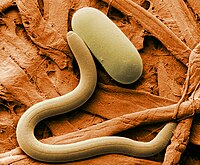
The transcriptomic changes of Huipizhi Heidou (Glycine max), a nematode-resistant black soybean during Heterodera glycines race 3 infection.
Sign Up to like & getrecommendations! Published in 2018 at "Journal of plant physiology"
DOI: 10.1016/j.jplph.2017.11.001
Abstract: Glycine max (soybean) is an extremely important crop, representing a major source of oil and protein for human beings. Heterodera glycines (soybean cyst nematode, SCN) infection severely reduces soybean production; therefore, protecting soybean from SCN… read more here.
Keywords: soybean; huipizhi heidou; infection; heterodera glycines ... See more keywords

An expanded role of the SNARE-containing regulon as it relates to the defense process that Glycine max has to Heterodera glycines
Sign Up to like & getrecommendations! Published in 2019 at "Journal of Plant Interactions"
DOI: 10.1080/17429145.2019.1622043
Abstract: ABSTRACT The defense regulon has been defined genetically in Arabidopsis thaliana to involve the syntaxin PENETRATION1 (PEN1), the secreted glucosidase (PEN2) and an ATP-binding cassette (ABC) transporter (PEN3). Experiments in Glycine max (soybean) have identified… read more here.
Keywords: defense; regulon; defense process; heterodera glycines ... See more keywords

First Report of the Soybean Cyst Nematode, Heterodera glycines, in New York
Sign Up to like & getrecommendations! Published in 2017 at "Plant Disease"
DOI: 10.1094/pdis-06-17-0803-pdn
Abstract: The soybean cyst nematode (SCN), Heterodera glycines Ichinohe, is the most damaging pathogen of soybean (Glycine max (L.) Merr.), causing more than $1 billion in yield losses annually in the United States (Allen et al.… read more here.
Keywords: soybean cyst; cyst nematode; soybean; heterodera glycines ... See more keywords

Interactions among Heterodera glycines, Macrophomina phaseolina, and soybean genotype.
Sign Up to like & getrecommendations! Published in 2022 at "Plant disease"
DOI: 10.1094/pdis-06-21-1169-re
Abstract: Heterodera glycines, the soybean cyst nematode (SCN) and fungal pathogen Macrophomina phaseolina, are economically important soybean pathogens that may co-infest fields. Resistance remains the most effective management tactic for SCN and the rhg1-b resistance allele… read more here.
Keywords: phaseolina soybean; macrophomina phaseolina; rhg1; scn ... See more keywords

Responses of Heterodera glycines and Meloidogyne incognita Infective Juveniles to Root Tissues, Root Exudates, and Root Extracts from Three Plant Species.
Sign Up to like & getrecommendations! Published in 2018 at "Plant disease"
DOI: 10.1094/pdis-09-17-1445-re
Abstract: The infective juvenile (J2) stage of endoparasitic plant nematodes uses plant chemical signals, released from roots, to localize and infect hosts. We examined the behaviors of soybean cyst nematode (Heterodera glycines) and root-knot nematode (Meloidogyne… read more here.
Keywords: exudates root; plant; meloidogyne incognita; root exudates ... See more keywords

Chromosome‐level reference genome of X12, a highly virulent race of the soybean cyst nematode Heterodera glycines
Sign Up to like & getrecommendations! Published in 2019 at "Molecular Ecology Resources"
DOI: 10.1111/1755-0998.13068
Abstract: Soybean cyst nematode (SCN, Heterodera glycines) is a major pest of soybean that is spreading across major soybean production regions worldwide. Increased SCN virulence has recently been observed in both the United States and China.… read more here.
Keywords: soybean cyst; cyst nematode; soybean; heterodera glycines ... See more keywords

FMRFamide-Like Peptide 22 Influences the Head Movement, Host Finding, and Infection of Heterodera glycines
Sign Up to like & getrecommendations! Published in 2021 at "Frontiers in Plant Science"
DOI: 10.3389/fpls.2021.673354
Abstract: The FMRFamide-like peptides (FLPs) represent the largest family of nematode neuropeptides and are involved in multiple parasitic activities. The immunoreactivity to FMRFamide within the nervous system of Heterodera glycines, the most economically damaging parasite of… read more here.
Keywords: movement; infection; flp; heterodera glycines ... See more keywords

Evaluation Soybean Cultivars for Reaction to Heterodera glycines Populations HG Types 7 and 1.3.4.7 in Northeast China
Sign Up to like & getrecommendations! Published in 2023 at "Life"
DOI: 10.3390/life13010248
Abstract: Soybean cyst nematode Heterodera glycines (SCN) is a major threat to global soybean production. Effective management of this disease is dependent on the development of resistant cultivars. Two SCN HG Types, 7 and 1.3.4.7. were… read more here.
Keywords: northeast china; glycines populations; soybean; soybean cultivars ... See more keywords